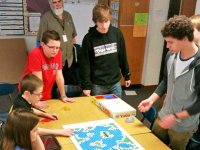PBL Pilot: 4 Strategies to Implement and Spread PBL in Your School
Two fifth grade teachers advocate trust, respect, and inclusion when sharing the practices and results of their PBL pilot program with on-site colleagues.
Editor's note: Matt Weyers and co-author Jen Dole, teachers at Byron Middle School in Byron, Minnesota, present the eighth installment in a year-long series documenting their experience of launching a PBL pilot program.
Implementing PBL in our middle school this year has been a journey of love, labor, and professional growth. We have found throughout this journey that a close working relationship with families and district administration has proven essential to building trust and securing the level of success that we feel we've attained this year. However, the group that we've struggled to fully engage has been our fellow staff. In the true nature of dichotomy, we have been extremely public about our adventures within our community and on social media, but have stayed relatively private within our school.
We felt that the online education community was the perfect venue to begin sharing our practices while we were gaining PBL experiences and gauging our district's readiness to embark on the PBL conversation. This leads us to one of our most interesting questions yet -- how do we safely gauge interest for PBL among our colleagues? As suggested in Crucial Conversations by Kerry Patterson, et al, we feel the answer lies within the previous question -- we need to make the conversation safe.
Strategies to “Make It Safe”
1. Make It a Two-Way Street
All teachers are experts, so when you enter into conversation with another teacher about PBL, make a specific effort to learn something about how this teacher runs his or her classroom. This will facilitate learning by all involved parties, as well as ensure that everyone leaves the conversation feeling wanted and valued.
2. Recognize Previous Efforts
Professional educators are notorious for allowing their extreme passion for their students to translate into long hours on the job. Many of the lesson plans, units, and classroom routines that teachers utilize are the product of multiple years of fine tuning. It would be a daunting task for anyone to assume that the only way to bring PBL into their classroom would be to throw out the majority of the lessons and routines that they've worked so hard to generate. John McCarthy, our mentor from the Buck Institute for Education, recommends that teachers who are interested in PBL plan one PBL project per semester.
3. Utilize the Word "And"
This strategy, also taken from Patterson's Crucial Conversations, has proven particularly powerful. Patterson and his co-authors expertly describe how to use the word "and" to avoid getting caught in an either/or decision. For example, many of the teachers with whom we've discussed PBL have expressed concerns that if they were to utilize PBL, they would be forfeiting their ability to teach all of their essential curriculum. We feel an appropriate response would be, "Do you feel there is a way to teach your essential curriculum and engage your students in a meaningful, authentic project?"
4. Make Your Classroom an Open Door
It took us awhile to get there ourselves, but opening your classroom door to anyone and everyone once you're comfortable with PBL is a powerful tool for continuing the PBL conversation. Some of the best professional development that either of us has ever experienced was the "meeting after the meeting." This is the dialogue that often ensues after an important meeting, training, or observation, an opportunity for participants to break down and assimilate new information into their educational philosophies.
Our Results Using These Strategies
For the first few months, we had little interest from other staff. Now, seven months into our school year, we finally have teachers seeking us out for information and ideas on PBL. We were recently approached by staff from two entire grade levels expressing their interest in utilizing PBL next year. For us, this is profoundly exciting. Our tiny seed that we planted last summer has started to sprout. It has a long way to grow, but with the right nourishment, we will see a beautiful bloom in the not too distant future.
We look forward to hearing about how you and your colleagues share your thinking about PBL practice in the comments section below.
